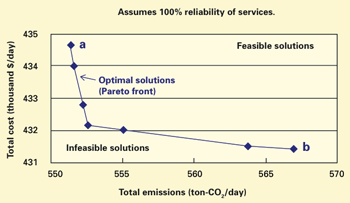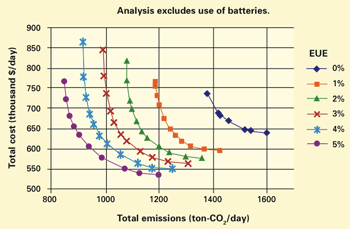
In the search for more reliable ways to provide electricity—and to incorporate renewable energy sources such as solar and wind—much attention is focusing on the microgrid, a small-scale power system that uses a combination of energy generation and storage devices to serve local customers. Research teams at MIT and the Masdar Institute are working to understand this option and how it can best be implemented.
In one project, researchers at Masdar have developed an analytical tool to help designers create the best possible microgrids for their needs, given the relative importance they place on minimizing emissions versus minimizing cost—two objectives that can’t be fully realized at the same time. For a defined level of demand and reliability of service, this powerful tool can determine the mix of devices and the strategy for operating them that will best meet the needs and preferences of the designer.
Meanwhile, a team at MIT is building a laboratory-scale microgrid that they will use to investigate questions arising from computer simulation studies. Using off-the-shelf equipment and computer programming, they’re making devices that behave like generators such as wind and solar energy systems, storage devices such as batteries, and customer loads such as fans and lights. When their microgrid is complete, they will see how well it operates, for example when it’s disconnected and reconnected to the central power grid—a necessary transition that simulations suggest may lead to voltage instability.
The flexible microgrid
An appealing feature of the microgrid is its flexibility. It can act as a stand-alone source of electricity for remote communities, or it can be connected to a central power system, selling and buying electricity as needed. In the latter setup, it can increase the reliability of service to customers by continuing to operate even when the central system goes down. And it can be a good venue for incorporating fluctuating sources of energy such as solar or wind. When the sun doesn’t shine or the wind doesn’t blow, microgrid operators can get power from their batteries or diesel generators, they can buy it from their utility, or they can reduce demand by cutting service to self-selected customers.
For the past four years, James L. Kirtley, Jr., professor of electrical engineering at MIT, and Hatem H. Zeineldin, associate professor of electrical power engineering at the Masdar Institute, have been collaborating on studies focusing on the microgrid. Working with others at MIT and Masdar, they are performing analytical and experimental studies designed to help bring about a future of abundant microgrids, each one tailored to serve its particular customer base as smoothly, reliably, and cost-effectively as possible.
A powerful planning tool
In designing a new microgrid, a major challenge—and opportunity—is deciding what components to choose and then how best to operate them to meet demand. “To serve my customers, I have to make a certain number of kilowatts at times of peak load and a certain number of kilowatt-hours per year,” says Kirtley. “Now the question is, How much generating capacity do I buy in solar PV panels and windmills? What do I need in diesel generators and batteries for backup? What mix will give me the performance I need at the least cost, or with the lowest possible emissions, or with some mix of the two?”
Unfortunately, those two objectives are inherently contradictory. In general, low costs mean high emissions, and vice versa. But system designers and operators may care more about achieving one objective than the other. Given those preferences, they need to decide how to configure and operate their microgrid.
To help in that decisionmaking process, Ahmed Saif, graduate student at the Masdar Institute, developed an analytical method based on “multi-objective optimization” techniques. Because system configuration and operations planning are interdependent, his method analyzes those two factors simultaneously, determining the costs and emissions associated with all possible options. Based on the results, the method generates a set of optimal designs and operating strategies that will minimize costs and emissions, assuming different weighting on those two objectives.
To demonstrate his method, he performed a case study that involved planning a stand-alone microgrid for a city of 50,000 residents—a size similar to that of Masdar City, Abu Dhabi, the location of the Masdar Institute and a city designed to be the first zero-waste, “net zero”-carbon community relying entirely on renewable energy sources. Based on published data, he calculated a pattern of demand similar to that of Abu Dhabi but scaled down to his community of 50,000.
In the case study, the proposed microgrid could include PV panels, wind turbines, diesel electric generators, and sodium sulfur batteries. The system should run as much as possible on its renewable technologies, using the diesel generators or batteries when more power is needed. Finally, the system should provide perfect reliability—that is, it should never fail to meet total customer demand.
Saif used information from commercially available sources to determine the capital, operating, and maintenance costs associated with each component. Based on fuel consumption, he calculated the operational carbon dioxide emissions of diesel generators—the only component in the system that produces emissions when it runs. But for every device in the system, he included “embedded” emissions, that is, emissions associated with making, installing, maintaining, and decommissioning the device. Including embedded emissions is critical to accurately represent the full environmental impacts of different generation options. Excluding them will yield a sub-optimal choice.
Results from his analysis appear in the figure below. The curve is the “Pareto front,” where each point is the optimal combination of design and operating choices for a given emphasis on one objective over the other (say, minimizing cost more than emissions). At any point on the curve, it is impossible to make one objective better without making the other one worse.
Micrigrid design and operation: Optimal choices for minimizing cost versus minimizing emissions

This figure shows results from a case study in which various component configurations and operating strategies were simultaneously evaluated for a microgrid being planned for a city of 50,000 people. Each point on the Pareto front is the optimal combination of design and operating choices for a given emphasis on minimizing cost versus emissions. At the extremes, point “a” minimizes emissions regardless of cost, and point “b” minimizes cost regardless of emissions.
The point marked “a” is the best choice if the only goal is to minimize emissions; point “b” is best to minimize cost, regardless of emissions. Interestingly, those two points differ by less than 1% in cost and 3% in emissions. The system configuration that minimizes cost also brings emissions close to the minimum attainable level, and vice versa. In both cases, the optimal system selected includes wind turbines, diesel generators, and batteries—but no PV panels.
Why is that? Because the wind turbine generators have the lowest cost and lowest emissions per kilowatt-hour of electricity delivered. When supplemented by large-scale storage, they can satisfy demand on the microgrid at most times. However, diesel generators are still needed when another generating unit fails and when storing wind-generated energy has not been feasible for long periods of time.
Relaxing the reliability
In another series of analyses, Saif assumed different levels of reliability and excluded the sodium sulfur battery option. (While that battery technology is promising, it has not yet been demonstrated at the scale needed here.) In these runs, he defined reliability in terms of “expected unserved energy” (EUE)—the expected amount of energy not supplied by the microgrid due to capacity deficiency.
Results of those analyses appear in the figure below. The Pareto front for 0% EUE—perfect reliability—shows the impact of excluding the battery option. Compared to the curve on this page, both costs and emissions are significantly higher at every point. That result demonstrates the importance of developing viable energy storage technology. But as the reliability constraint is relaxed—through accepting higher values of EUE—cost and emissions both decrease dramatically, largely because fewer system components are needed. Such results quantify the trade-offs available to the microgrid planner.
Microgrid design and operation: Impacts of varying reliability requirements

These results are from analyses that exclude the battery option and permit different levels of reliability, measured as “expected unserved energy” (EUE)—the expected amount of energy not supplied by the microgrid. Without batteries to store energy, both costs and emissions are higher. But permitting less reliable service (through higher EUEs) dramatically reduces costs and emissions. There is less need to buy and run expensive equipment to ensure continuous generation, for example, when the sun is down and there is no wind.
Testing microgrid behavior—at the laboratory scale
Simulation studies suggest that one of the biggest challenges for an operating microgrid may be disconnecting and then reconnecting with the central power system. When the power system shuts down, the microgrid may need to ramp up generation and possibly cut service to some customers; and when the power system comes back on, the microgrid must resynchronize with it for smooth operation. “Those changes should be made automatically, immediately, and seamlessly,” says Kirtley. “I like to call it a bump-less transition.”
Simulation studies by Ali H. Kasem Alaboudy, postdoctoral fellow at the Masdar Institute, and Zeineldin indicate one potential cause of problems during such transitions: the presence of inductive motors, the workhorses that run air conditioners, lathes, and other equipment common in industrial and commercial facilities. Simulation results show that when those motors are suddenly cut off by the central power system and restarted by the microgrid, voltage on the microgrid can become unstable.
To verify and further investigate those and other simulation results, Kirtley and his students at MIT are building a lab-scale analog—a “micro-microgrid”—on which they hope to replicate such operating challenges. They are using standard, low-tech devices (DC motors and switches and capacitors) plus sophisticated computer modeling based on detailed understanding of how specific generating components and energy-consuming devices work. As Kirtley says, “We’re phony-ing up a lot of things.”
For example, graduate student Michael Zieve of electrical engineering and computer science (EECS) is simulating a diesel engine using a DC motor and some power electronics. Jared Monnin, also a graduate student in EECS, is using the same approach to simulate a solar farm. Several other students are contributing to a simulated wind turbine, including the dynamics of wind gusts that contribute to the variability of electric power generated by wind turbines.
On the other side, the system will include a variety of “customers.” The team is incorporating inductive loads such as fans, and adjustable resistive loads such as light bulbs controlled by dimmers. The loads will be wired into the system through switches that can connect and disconnect them. All will be computer controlled.
Once the lab-scale microgrid is complete, the researchers will link it to the local power system through a standard utility circuit breaker box. They will then add one more critical component: a device that will protect the local power system from harmful effects as they create short circuits and other conditions intended to challenge their micro-microgrid. During those tests, the team will carefully monitor the behavior of every component as well as the overall system, gathering information that will provide guidance to designers who are planning microgrids with full-sized components and customers.
This research was supported by the Masdar Institute, a Founding Public Member of the MIT Energy Initiative. Further information can be found in:
A. Saif, K. Gad Elrab, H. Zeineldin, and S. Kennedy. Multi-Objective Capacity Planning of a PV-Wind-Diesel-Battery Hybrid Power System. IEEE International Energy Conference and Exhibition, Manama, Bahrain, December 18–22, 2010. DOI: 10.1109/ENERGY-CON.2010.5771679.
A. Alaboudy and H. Zeineldin. Critical Clearing Time for Isolating Microgrids with Inverter and Synchronous Based Distributed Generation. IEEE Power and Engineering Society General Meeting 2010, Minneapolis, Minnesota, July 25–29, 2010. DOI: 10.1109/PES.2010.5590125.
This article appears in the Autumn 2011 issue of Energy Futures.